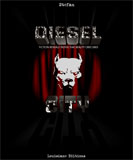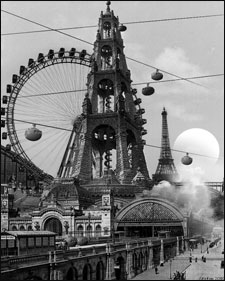
ON
DIESEL CITY
Louisiane Editions
ISBN: 978-2-918995-12-8
2012, 200 pp., $40.00
www.dieselcity.fr/en/
The following interview was conducted over email by Rattle editor Timothy Green and Stefan, artist and author of Diesel City, an artist’s guidebook through hundreds of his original illustrations. We were excited to feature six images from Diesel City in Rattle #38, including the cover and background image now featured on this website, and wanted to learn more about Stefan and his work.
Stefan is a professional artist and author living in Paris, France. Heavily inspired by the pop culture of the 1930s and 1940s, Stefan has created several books and countless illustrations in his unique dieselpunk style. By combining motifs ranging from Film Noir and Art Deco to classic advertising and Totalitarian art, his groundbreaking work in the retrofuturist community bridges the gap between history and fantasy. This impressive portfolio is finally available for the first time in Diesel City, a tale years in the making. Stefan is also the art director of various films. He is currently working on HEMERAPOLIS, a short movie by French director Jean Dellac, based on a novel by Jules Verne.
__________
GREEN: When I first stumbled across your work, what drew me in was the grittiness of its irreality. So much of science fiction art seems filled with “stainless enthusiasm,” as you put it in the book. It feels too clean to be real. But Diesel City is a tangibly dirty place. In the notes to the book, you write that the motto of the genre is: “Dieselpunk, because Steampunk wasn’t dirty enough.” Can you explain how the Dieselpunk movement arose, and what drew your art in that direction?
STEFAN:  Well, some say Dieselpunk stemmed from Steampunk, which supposedly branched off Goth style itself, which derived from… All this is, in my opinion, just local quarrels. It’s true, indeed, that there is some chronology to this, since Steampunk draws its inspiration from the Victorian-Edwardian era, the late 19th-early 20th century, when Dieselpunk finds its own sources of inspiration in the Interbellum era (1918 – 1939) technology, aesthetic, arts—even politics and sociology. In other words, Dieselpunk is the chronologically following genre. Except that we’re not talking “real” history here, but alternate history.
Well, some say Dieselpunk stemmed from Steampunk, which supposedly branched off Goth style itself, which derived from… All this is, in my opinion, just local quarrels. It’s true, indeed, that there is some chronology to this, since Steampunk draws its inspiration from the Victorian-Edwardian era, the late 19th-early 20th century, when Dieselpunk finds its own sources of inspiration in the Interbellum era (1918 – 1939) technology, aesthetic, arts—even politics and sociology. In other words, Dieselpunk is the chronologically following genre. Except that we’re not talking “real” history here, but alternate history.
This most convenient classification is probably part of the reason why the ironic motto links the two genres to each other. Both “subcultures”—to use the official term—have their own aficionados, but many of them have an interest in both genres. Both Steampunk and Dieselpunk, along with some other sub-genres, belong to the Retrofuturist movement, anyway. As for me, just as Molière’s The Bourgeois Gentilhomme was speaking in prose unbeknownst to himself, I found out someday I was “doing Dieselpunk stuff” for many years and didn’t even know it. The Interbellum era has always been very inspirational to me, to say the least and most of my graphic work is related to the mid-century styles in one way or another. Imagine how delighted I was when I realized there was a whole community around with the same interests, very active and creative.
GREEN: You also refer to that motto as “self-derisive,” and I get the impression throughout that Diesel City is balancing on a line between the serious and the tongue-in-cheek. This is a world where “Celestial Palaces, Ltd.” builds resort hotels on asteroids, only to have them become lost in space, and where global warming is seen as “a beautiful special effect.” But there’s also plenty of commentary on war and illusion and consumerism in our own contemporary dystopia. How can a work be somber and playful at the same time, and what do you gain by creating a world that is both?
STEFAN: These are the two faces of the same coin, the key to understanding these complex, immensely rich and productive two decades from which our whole modern world is derived. The main characteristic of the Interbellum era—and probably what makes it so dense and inspirational—is this ambivalence, the simultaneous joie de vivre, the faith in progress and future, and the dark perspectives on its horizon. The ’20s and the ’30s were the time for Art Deco and Streamline, for modern art and women’s liberation; they’ve seen the jazz age and the birth of consumerism, but these same decades were also heavily darkened by the Great Depression in the U.S., subsequent financial crises everywhere, the raising of nationalism, totalitarism, and dictature in all major European countries and, of course, the terrible threat of another world war ahead—something the whole Western civilization had so hoped not to ever see again after WWI. From an intellectual, artistic point of view, I’ve always thought this previously unseen, weird association of such opposite moods, with its crescendo spanning over these two decades to finally reach a dramatic, tragic climax, generated a thrilling combination that can be endlessly translated in many ways in literature, visual arts, etc. It actually never ceases to be used as a background in films, books, video games, etc. up to nowadays, for the best or for the worse.
GREEN: Diesel City is an art book, but it’s also full of poetry. Each page includes what might be described as a prose poem that helps to guide us through this alternate reality. And it’s full of great lines. Of the Megalopolis you write: “You can visit the big city, but you can never approach it.” On a propaganda campaign: “…war is human nature, they’re killing you to say.” Did you write all of this yourself, both in French and in English? I imagine all of the illustrations were created first—what were you trying to accomplish with the prose?
STEFAN: I’m by no means a writer, I hasten to say—and that makes the honor of being featured in Rattle even greater to me—but yes, I wrote these prose poems myself , as you are kind enough to call them. I first wrote them in French and did the best translation I could. And that is when I’ve been very lucky. Tome Wilson, one of the leading voices of the Dieselpunk genre and the owner of the Dieselpunks website (www.dieselpunks.org), the epicenter of everything Dieselpunk on the Internet, kindly agreed to adapt my own very awkward text for the English version of Diesel City. What more could I ask for, really? If someone could ever grab the feel of Diesel City, that was certainly Tome. Tome faithfully stuck to the original dark mood of the book, but brought in it his own sensitivity, too. He also did a wonderful job about the notes of the books, bringing into them his extensive knowledge of the Dieselpunk culture, thus turning something that usually nobody reads into a precious resource about the art and technology of the Interbellum. The illustrations were created first indeed, but I wanted these short prose poems to somehow bring the pictures to life and link them together into some sort of narration, although not a linear one, guiding the viewer/reader throughout this hypnotic dive into the dystopian universe of Diesel City.
GREEN: Is there anything you can tell us about your creative process? Where do you find inspiration? Do you view this world as a real place in your mind, with a history and full storylines, or does each image come to you as a snapshot? There must be well over 100 illustrations in the book. Do you draw from any source material?
STEFAN: Like I said, most of my graphic work, if not all, is inspired by and/or related to the Interbellum. I’m lucky enough to live in Paris, where many places still retain that pre-WWII flavor but, most of all, where countless exhibitions, museums, libraries are available, offering virtually endless resources about what these two decades were made of: architecture, furniture, painting, sculpture, fashion and much more.
With such a monolithic, narrowly focused source of inspiration, quite naturally, all my pictures have a lot in common. They somehow can be seen as a whole. This gave birth to the idea of some imaginary universe stuck in what I’m used to calling my own personal “twisted forties,” a place in some alternate timeline, a city encapsulating and exacerbating all the ambivalence of the era, its aesthetic, political, technological specificities, as complete as possible. Diesel City includes a rather huge amount of images, indeed, some from a few years ago, some more recent. It was a challenge to gather all this material in just one book and that is where the texts helped a lot. It was also a challenge—it always is for a graphic designer, a writer, a musician, I guess—to get back to some work done a few years ago but, all in all, I’ve been happy to realize all this; the recent work and the not so recent, was quite consistent. I believe we’ve achieved something coherent.
From a technical point of view, all my work is computer generated for several years, now. Over the past years, I’ve become more and more reluctant to use traditional media anymore—shame on me—and also, computers and graphic software offer such endless possibilities nowadays, thus gaining the status of a “real,” respectable media, that it’s almost impossible for a graphic designer not to be tempted. My images are a combination in varying proportions of vintage photographic elements, “traditional” digital graphism, if such a thing exists and 3D. I’ve found that the digital media, thank to this combination, is best offering to me the ability to almost tangibly bridge the gap between past, present and future inside one graphic work.
That is also the idea the quite sophisticated layout of the pages in Diesel City tries to visually convey, to materialize. In each page, illustrations blend with original vintage photographs in the background and the short texts, each of them overlapping the other, thus blurring the line between reality and fiction and somehow forcing the reader to go through a first evident level of reality to access a different timeline behind. Things hidden behind things. I guess this is the idea in my entire graphic creation process and, since Diesel City, in my modest attempt at writing, too. That is also the manifesto the subtitle of the book pretends to express. “Fiction Reveals Truths That Reality Obscures.”
GREEN: What’s next for Diesel City? I noticed on the back flap that we should be on the lookout for a sequel, Silent Empire. Is there anything you can tell us about the next book?
STEFAN: Silent Empire is definitely more of a prequel to Diesel City than a sequel. It is the heart and foundation of this above-mentioned concept of a city-universe trapped in some alternate reality Diesel City gives a visual representation of, captioned with the prose poems.
Both the aimed goal and the creation process of Silent Empire and Diesel City are completely different. Silent Empire will—hopefully—be an illustrated book, some sort of graphic novel including many illustrations but also a “real” plot, whereas Diesel City is mostly an art book. As for the writing, a very talented writer, Bard Constantine (bardconstantine.jimdo.

__________
For more information:
Take a trip to Diesel City yourself, and view the video trailer, browse the gallery, and read excerpts at the book’s official website (www.dieselcity.fr). More of Stefan’s work, including recent illustrations, can be viewed at his Deviant Art page (stefanparis.deviantart.com).
Comments are closed.